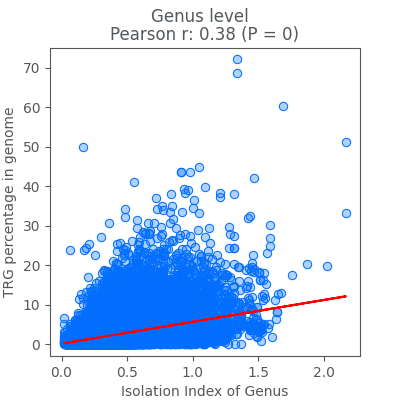TRGdb
TRGdb is a database of taxonomically-restricted genes (TRGs) in Bacteria. The website allows users to browse and search for TRGs, at the genus and species levels, across different taxonomic units of Bacteria. It provides full taxonomic information on bacterial species as well as Separation Index of Organism, which quantifies the separation degree of given species/genus from all closest bacteria. Finally, the website provides information on every TRG protein sequence including their properties (e.g., level of disorder and complexity, and tendency to aggregation).
SearchDatabase content
| Bacteria species | 80,789 |
| Bacteria proteins | 247,617,414 |
| Bacteria species with at least one TRG | 80,778 (99.99%) |
| TRG proteins (total) | 10,737,409 (4.34%) |
| - TRG proteins (genus level) | 5,514,533 (2.23%) |
| - TRG proteins (species level) | 5,222,876 (2.11%) |
| TRG protein clusters (total) | 8,434,088 |
| - TRG protein families (genus level) | 3,339,679 (39.60%) |
| - TRG protein families (species level) | 5,094,409 (60.40%) |
TRGs across bacterial species
Number of bacterial species containing a specific number of TRG genes.
Percentage of TRG proteins across bacterial species
| First quartile | Median | Third quartile | Max | Mean | |
|---|---|---|---|---|---|
| Genus | 0.8% | 1.5% | 2.9% | 72.1% | 2.38% ± 2.76% |
| Species | 0.7% | 1.5% | 2.8% | 62.4% | 2.14% ± 2.37% |
| Total | 2.4% | 3.6% | 5.5% | 77.3% | 4.52% ± 3.39% |
Size of TRG protein clusters
| Level | Clusters count | First quartile | Median | Third quartile | Max | Mean |
|---|---|---|---|---|---|---|
| Genus | 3,339,679 | 1 | 1 | 1 | 2932 | 1.7 ± 4.9% |
| Species | 5,094,409 | 1 | 1 | 1 | 283 | 1.0 ± 0.4% |
| Total | 8,434,088 | 1 | 1 | 1 | 2932 | 1.3 ± 3.1% |
TRG abundance and isolation of bacterial organism
Relationship between the numbers of TRGs as a percentage of total proteins and Isolation Index of an Organism.


Properties of TRG protein sequences
Comparison of protein sequence properties between TR genes at the genus and species levels. Horizontal red line indicates the median value calculated from a random sample of non-TRG bacterial proteins (n = 8,489,929).
